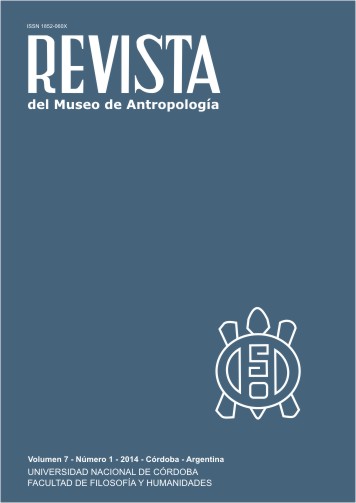“I want to see Sibipiruna growing”. Roda de samba networked
DOI:
https://doi.org/10.31048/1852.4826.v7.n1.9105Keywords:
samba de roda, affection, creativity, networkAbstract
This work proposes to explore the sociotechnical construction of roda de samba (round of people doing samba), from the starting point of affect. Affect constitutes potential spaces (Winnicott: 1971) that encourages individual and collective creativity and amplifies experience. I have been in São Paulo, Brasil in 2012, doing an academic stay at Universidade Estadual de Campinas. There I conducted an ethnographic research about a group of sambistas that develop an open roda de samba project. This project is made up of a monthly meeting in which musicians form an open round of people. It is also constituted by an everyday online contact through sociotechnical platforms. This group of samba become round every first Sunday of month in the meeting, and online every dayDownloads
References
Aderaldo, G. y Fazzioni, N. 2012. Choro e samba na Luz: etnografia de práticas de lazer e trabalho na R. Gal. Osório. En Ponto Urbe (online) n11 (consultado en agosto de 2013) http://www.pontourbe.net/edicao11-dossieluz/265-choro-e-samba-na-luz-etnografia-de-praticas-delazer-e-trabalho-na-r-gal-osorio
Bijker, W. 1995. Of bicycles, bakelites, and bulbs: Toward a theory of sociotechnical change. MIT Press, Cambridge.
Bijker, W., Thomas, H. y Pinch, T. 1989. The Social Construction of Technological Systems: New Directions in the Sociology and History of Technology. MIT Press, Cambridge.
Bourdieu, P. 2007. El sentido práctico. Siglo veintiuno editores, Buenos Aires.
Enriquez-Rosas, R. 2000. Redes sociales y pobreza: mitos y realizades en Revista de estudios de género La ventana, II. UdeG. Pp. 36-72, México.
Guber, R. 2001. La Etnografía: método, campo y reflexividad. Norma, Buenos Aires.
Horst, H. y Miller, D. 2012. Digital Anthropology. Berg, London.
Ingold, T. y Hallam, E. 2007. Creativity and Cultural Improvisation. Berg, Oxford.
Larsen, J. 2008. Practices and Flows of Digital Photography: An Ethnographic Framework. Mobilities 3, 1. Pp 141-160.
Manning, E. 2010. Always more tan one: The Collectivity of a life in Body & Society. Vol 16. Sage Publications. Pp. 117-127, London.
Manovich, L. 2008. Software takes command. Creative Commons License. Derivative works 3.0 United States License. http://www.google.co.uk/url?sa=t&rct=j&q=&esrc=s&frm=1&source=web&cd=1&ved=0CDEQFjAA&url=http%3A%2F%2Fsoftwarestudies.com%2Fsoftbook%2Fmanovich_softbook_11_20_2008.doc&ei=EO9BUZWnBcyuPLyFgNAL&usg=AFQjCNG63dkSp2p6bae5WZjG1wgAAw4-IA&sig2=mp_9IbMcrQ1zXGnJ9Fr3nA&bvm=bv.43287494,d.ZWU
Márquez, I. 2011. Música y experiencia: de las sociedades primitivas a las redes sociales. En Revista de Antropología Iberoamericana, Mayo- Agosto de 2011. Antropólogos Iberoamericanos en Red. Pp: 193-214, Madrid.
Mauss, M. 1979. Ensayo sobre los dones, razón y forma del cambio en las sociedades primitivas en Sociología y Antropología. Tecnos, Madrid.
Moura, R. 2004. No princípio era a roda. Estudo sobre o samba, partido alto e outros pagodes. Rocco, Rio de Janeiro.
Nogueira, N. 2006. Dossiê das Matrizes do Samba no Rio de Janeiro. Centro Cultural Cartola, Iphan e Ministério da Cultura, Rio de Janeiro.
Sandroni, C. 2010. Samba de roda, patrimônio imaterial da humanidade. En Estudos Avançados (online). vol.24, n.69. (consultado en agosto de 2013) Pp. 373-388 http://www.scielo.br/scielo.php?script=sci_arttext&pid=S0103-40142010000200023&lng=pt&nrm=iso>. ISSN 0103-4014.http://dx.doi.org/10.1590/S0103-40142010000200023.
Skågeby, J. 2008. Gifting Technologies – Ethnographic Studies of End-users and Social Media Sharing. Department of Computer and Information Science Linköpings universitet Linköping. SE-581 83, Sweden.
Sluzki, C. 1996. La red social: Fronteras de la práctica sistémica. Gedisa, Barcelona.
Winnicott, D. 2005. Playing and Reality. Routledge Classics, London.
Downloads
Published
Issue
Section
License
Those authors who have publications with this Journalaccept the following terms:
a. Authors will retain their copyrights and guarantee the journal the right of first publication of their work, which will be simultaneously subject to the Creative Commons Attribution License (Licencia de reconocimiento de Creative Commons) that allows third parties to share the work as long as its author and his first publication in this journal.
b. Authors may adopt other non-exclusive licensing agreements for the distribution of the version of the published work (eg, deposit it in an institutional electronic file or publish it in a monographic volume) provided that the initial publication in this journal is indicated.
c. Authors are allowed and recommended to disseminate their work on the Internet (eg in institutional telematic archives or on their website) before and during the submission process, which can lead to interesting exchanges and increase citations of the published work. (See The Effect of Open Access - El efecto del acceso abierto)












